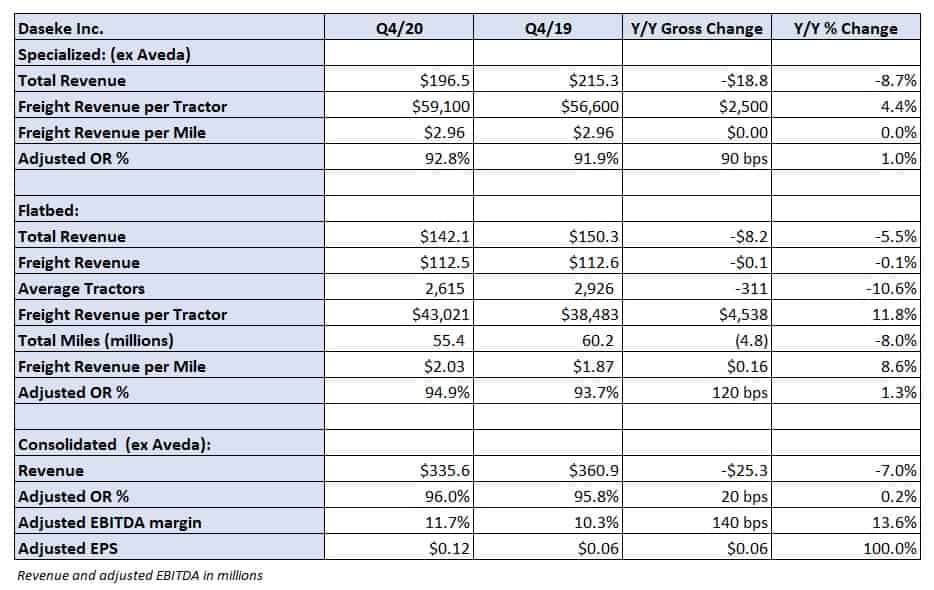Daseke’s (NASDAQ: DSKE) go-forward strategy will expand on its recently completed operational restructuring and include accretive acquisitions. Those plans were outlined in an interview FreightWaves had with Interim CEO Jonathan Shepko and CFO Jason Bates.
On Friday, the nation’s largest flatbed truckload provider reported fourth-quarter adjusted earnings per share of 12 cents, excluding results from a divested unit. That was better than the consensus expectation calling for a 4-cent loss and last year’s 6-cent result.
Next phase of streamlining operations
The heavy lifting for Daseke has been completed. Those efforts included consolidating its network of separately operated carriers from 16 to nine, divesting its oil rig transportation segment Aveda, disposing underutilized equipment, reducing headcount and building out its C-suite.
Several financial improvements were recorded in 2020 as a result of the initiatives.
The company’s full-year adjusted operating ratio improved 280 basis points year-over-year, excluding Aveda’s results, to 93.6%. Adjusted earnings before interest, taxes, depreciation and amortization increased 15% to $179 million. Free cash flow generated was almost $40 million higher to $169 million. Net debt was reduced by $105 million, which lowered net debt-to-adjusted-EBITDA to 2.6x from 3.2x at the end of 2019.
The next phase of the operational evolution is expected to be more of a refinement, which includes technology investments and workflow optimization. As the separately operated companies come together on one information platform, decision-making is expected to improve by using real-time data and analytics.
“It’s thinking about not only providing these capabilities in a siloed manner within each of our nine respective op-cos, but then also using that technology enterprisewide to facilitate better-conforming practices, better-conforming decision-making,” said Shepko. The goal is to make better decisions around freight optimization and pricing.
The full-year 2021 guidance — revenue between $1.4 billion and $1.5 billion, which brackets the $1.47 billion consensus estimate, and adjusted EBITDA of $165 million to $175 million, slightly lower year-over-year, seems disappointing at first blush. The stock closed the day 7.5% lower compared to the S&P 500, which was off 2%.
However, Daseke has roughly a $30 million EBITDA headwind in 2021. There was a meaningful increase in high-margin wind energy freight in 2020 as construction schedules were accelerated to take advantage of renewable energy production tax credits that were set to expire. The credits have been extended through the end of 2021, but the pipeline will not be as robust as it was, meaning less likelihood of the more profitable project freight this year. Additionally, 2021 insurance expense will be $8 million higher.
The good news for Daseke is flatbed volumes are holding firm and rates have turned positive. The company expects rate increases in the mid-single-digit range this year, which should be enough to offset insurance and other cost headwinds like driver wage inflation. Add in cost synergies from operating and fleet performance initiatives, and the guidance is more palatable.
Bates said the goal to reach a 90% OR hasn’t changed. “There’s still a lot of fruit, really low on that tree for us to go and get,” he commented on the company’s conference call with analysts. He noted that some of the optimization plans are a little harder but that they “don’t need a ton of help from the market” to accomplish them as they “haven’t leveraged the scale of the organization yet.”
Getting back to growth mode
The company took a two-year hiatus from acquisitions to clean up what it had already brought on board over the past decade. Improved financial results, better cash generation and debt deleveraging will aid in the M&A effort.
“The M&A opportunity is absolutely back in our crosshairs,” Shepko said.
Daseke is looking to make medium-size tuck-in deals that will be accretive quickly. It is seeking to acquire carriers that operate in the geographies and end markets that Daseke is trying to break into.
The M&A strategy now is more defined as acquired entities will be layered into existing, well-run operating companies. This is different from the old strategy, which was to acquire carriers and allow them to be run as a stand-alone operation. That approach didn’t provide many operating synergies or cost efficiencies.
Management said they have learned much from the recent operational overhaul and that a more streamlined approach to M&A will allow them to target the brands, capabilities and areas they want to operate in without inheriting the full cost structure of the acquired fleet.
Further, the company has more bandwidth on the executive roster. Shepko stepped in to lead the day-to-day following the abrupt resignation of the former CEO at the end of 2020. He’s held leadership positions focused on energy and infrastructure at private equity firms. Bates joined in April. He has managed the finances for some of the industry’s largest carriers. In between, the company has added chief operating, information and chief people officers.
Demand trends are improving
Management said signs of a rebound are evident. The company hasn’t experienced the normal seasonal slowdown this January as construction activity remains robust, keeping loads of lumber, glass and gypsum moving. Mild weather has also been a tailwind for building. On the other side of the coin, soft demand in the aerospace sector and many large-scale manufacturing operations remaining below pre-pandemic production levels are still detractors.
Revenue declined 7% year-over-year, excluding Aveda, in the fourth quarter due to a slowdown in project freight and COVID overhangs on many manufacturing verticals.
Revenue in the company’s specialized freight segment was 9% lower, excluding Aveda, but revenue per tractor was up 4.4% on a flat rate per mile. The OR deteriorated 90 bps to 92.8% on increased insurance costs, which were partially offset by the turnaround initiatives.
The flatbed segment experienced similar fundamentals, which led to a 5% year-over-year reduction in revenue as the average tractor count declined 11%. Rate per mile was up 9% and revenue per tractor climbed 12%. The division’s OR slid 120 bps to 94.9%.








